teaching
now browsing by tag
Highlighting the Positive of Covid Lesson Planning: Finding the Convergence of Content and SEL
Blog post written by Region 11 Representative, Holly Meade

Holly Meade is a Middle School Visual Arts teacher at Downingtown Middle School. She has a BFA, M.Ed in Childhood Development, and additional certifications in ESL and SEL. Region 11 PAEA rep
I am currently teaching virtually, predicted to soon to be hybrid, but anticipating anything can happen and probably will, going back with 2-days notice, wearing a hazmat suit to class, anything. I counted the amount of times I heard the word fluid during a zoom meeting, 9. Fluid is the new moist, the word is dead to me now, a Covid vocabulary casualty, joining unprecedented. As an attendance check-in, I asked my students to describe 2020 in one word, here are some responses: canceled, oof, oop, crazy, disaster, worst (most popular answer), exhausting, my personal favorite… dumpster-fire (I let that slide as one word), luckily no one used unprecedented. Whatever word you choose to describe what’s going on right now, it’s stressful and become more important than ever that we create a space that’s welcoming, supportive, and safe. An environment where content connects rigor and engagement with social and emotional learning (SEL). A meaningful convergence.
Art teachers are naturals at creating projects which spark joy, are hands-on, engage students authentically and our lesson design process naturally fits into the UbD format. Many school districts are imparting SEL into advisory blocks or guidance department lead lessons, but how do make this sustainable and creatively connect the SEL and content in an authentic way.
You can build upon what your district or individual school has been spotlighting or reinforce it. Many schools are focusing on self-management which is regulating emotions and managing stress. I examined my curriculum and lessons that I would be doing if we were in person and adjusted the content to converge with SEL domains that were not already being covered by school mandated lessons, like stress management. On a side note, I’m not managing my stress well, so I didn’t feel this was a skill I could model at this moment. I do not see recreating lessons as additional work, I see it as an opportunity to examine what is important to creating a safe supportive space that supports social and emotional learning while not sacrificing content or rigor. The examination gave me the opportunity to work SEL into the content lessons in a meaningful way. For example, when reflecting upon the dumpster fire (now one word) that is happening around us. I looked at my own children and how they were feeling powerless and without a meaningful voice. This prompted me to recreate a unit called Artists and Identity and add Voice to the mix. I found it manageable to re-create my content by highlighting just 2 of the 5 SEL domains, self-awareness, and social awareness. Because of the change in teaching format to virtual, I had to recreate how I am delivering content anyway, and when (if) we return to in-person learning, who knows what sharing supplies will look like, so it is great timing for an update. Yes, I found one positive in 2020 lesson planning. Using essential questions that tie emotions with content is another way to practice and model SEL skills while building connections.
Art is empowering. Teaching and modeling how artists use their voice for change and to highlight social issues has been amazing. We are making connections of voice and historical context using Dorothea Lange to the NBA uniforms and the work of a local artist, Russell Craig. I wish I had always given them more opportunity for discussion! We often underestimate how much our students are paying attention to the events of the world and their ability to talk about it. But like Mr. Rodgers said, “Anything human is mentionable and anything mentionable is manageable.” Taking time to create a safe, supportive space is essential for building an environment where students can connect and discuss challenging feelings, which teaches, models, and gives students an opportunity to practice SEL skills like empathy. We do need to evaluate our environments and do everything with compassion. Not just in Covid class, always in our class.
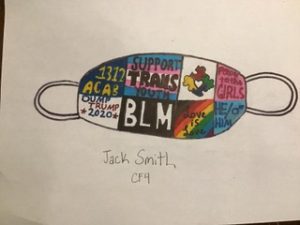
Intro design project building voice, identity, and empathy by letting others see our voice and letting someone else into your world
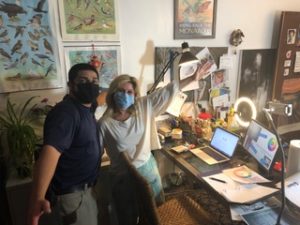
Embracing the chaos with the Comcast technician 20 minutes before hosting virtual Back-to-School Night
I’ve been teaching for a while now . . .what’s next?
I’ve been teaching for a while now . . .what’s next?
Discovering what opportunities exist for Art Educators when considering Master’s Programs.
So you have been teaching for a while now and you are considering what is next? For many of us, teaching is a way of life, and seeking ways to better our practice is simply intuitive. But deciding the best way to acquire that learning and what those extra steps will do in the long run can be difficult to answer. My name is Ben Hoffman and I am the Visual Arts Teacher at Kutztown Area High School. Since graduating from Kutztown University in 2015, my journey has taken me to Philadelphia, Baltimore, and back. I have been incredibly fortunate to teach and work in museum settings, galleries, community arts centers, summer arts programs, and public-school settings. In addition to my range of experiences in teaching, I currently serve as the PAEA Region10 Representative as well as chairman of the Kutztown University Arts Society.
As an Art Educator, you are equipped with far many more talents and experiences than what our certification deems. Teaching K-12 is merely one of the many rewarding opportunities that we have available. This past year, I successfully completed my fourth year at Kutztown Area High School as well as graduated with my Master’s in Art Education from Kutztown University. For many of us, working towards our Master’s in Education is often most appropriate and considered an acceptable pathway when pursuing our Level II Certification. Unlike my undergrad experience, the courses in my Master’s program were directly driven to my pedagogy and helped enrich the quality of my program. Much of any undergraduate program is directed towards the understanding of pedagogy and curriculum while my time as a graduate student applied that theory to practice. From rewriting curriculum, developing new courses, embodying a new mindset for teaching, and advocating for our growing program, my experience as a graduate student was unbelievable.
Regardless of the path that you may take, it goes without saying that it will take time and energy. I was highly motivated to learn just as much as I wanted to move up on the pay scale. But just recently, I stood at the crossroads of no school and yearning that desire to continue to grow. This is when I then contemplated other master’s programs and even my doctorate. Now that I have my Master’s In Art Education, what more can I do?
Connecting with people and establishing those relationships is the foundational piece to making any impact. Now having my Masters in Art Education, I am considered qualified to teach in non-traditional settings, serve as a nonprofit program director or even an instructional designer. Each of these professions seemed equally interesting, but I still wanted to know what more was available. This is when I stumbled upon a Master of Arts in Arts Administration. Unlike the education world, Arts Administration extends opportunities to individuals who are equally as dedicated, talented, and passionate as the artists and audiences they support.
The nonprofit arts sector generates nearly $170 billion in economic activity each year according to the America for the Arts economic impact study. Because of this economic and political impact, the public sector, arts, and cultural organizations are increasingly seeking trained professionals to provide vision and leadership. (Kutztown University, 2019) While teaching is one of the most rewarding fields there is the experiences that could be acquired from such a unique program that sparked my interest and felt applicable to the events our district puts on. I saw this opportunity as the key to my success in being able to learn and value the connection I share as an artist, educator, and advocate. Whether coordinating large-scale festivals, serving as a museum or gallery director or simply coordinating community events, this was the next step in my journey as an art educator.
Often a master’s program can feel daunting and overwhelming, but from my own experiences, that deep investigation of the arts and its cultural impact throughout time and across cultures have significantly impacted the person that I am today. Since graduating with my Master’s in Art Education, the excitement to grow as an educator has equally fueled my artistic practice and understanding of leadership. Furthermore, having that deepened understanding of our roots in history has helped shaped my appreciation for our field and the impact we continue to make. I would be remised to look back and appreciate all that every art educator has done to pave the groundwork for my future.
While I begin my second Master’s, I continue to question all things and continue to seek the most meaningful connections for my own classroom. While writing papers and reflecting may seem like much of any graduate program, the conversations between like-minded peers in the field are incredibly valuable. Furthermore, serving as Chairman of the Kutztown University Arts Society has challenged my own best practices and demanded that I view the Arts from a unique perspective. While teaching comes with its own set of principles and expectations, leading a group of professionals who each come with a diverse set of experiences and skills has its challenges. It is those difference and range of perspectives that cultivate a healthy and successful arts organization. It is incredibly interesting to see how my perspectives as a teacher are often valued in these new settings when working alongside those in higher education.
It is never an easy decision to make when picking a program. Every district will have different procedures and should be considered when selecting a program. I am incredibly fortunate that my district values teachers to continue their education. While loans and time may be a burden, know that there are countless opportunities and ways in which you can tailor the best program for you. I was determined to finish in three years. For others in the program, there was a range of flexibility. Some students were those who decided later in life to pursue their master’s while some students had transitioned directly from their undergraduate program full-time.
Regardless of the path that you may decide or the timeline you establish for yourself, know that you will never regret the experience. Any graduate program you choose will demand that you set aside time to work and reflect, but just as you now actively participate in PAEA, you will have no problem in accomplishing this goal. For many, just like myself, you may never know where the Arts will take you, but as long as the Arts are alive and healthy, there will be nothing but success in your future. Every story will be different. I am incredibly grateful for my experience as a graduate student and look forward to my time as an Arts Administration student.
I hope that my story inspires you to take that next step in whatever your journey has in store for you. No matter the path, the Arts will always be there as will PAEA to support you in all professional development endeavors. If you should have any questions, comments, or concerns, please do not hesitate to contact me directly. I am more than happy to extend my knowledge and support each of you in the best ways that I can. Thank you again.
Respectfully,
Benjamin E. Hoffman
Kutztown Area High School
Visual Arts Teacher
bhoffman@kasd.org


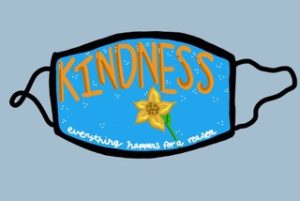
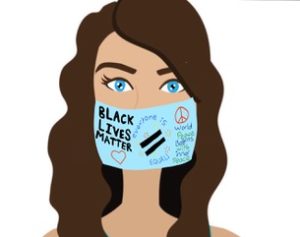
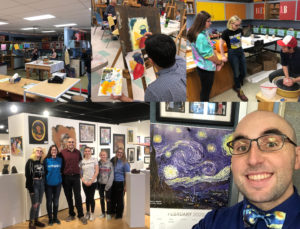
 D5 Creation
D5 Creation